The Home GHR, according to inventor Brian Schwab is “a floor based glute ham raise that is affordable for home gym users with the benefits of a full scale model. It adjust from 39.5″ to 46.5″ in length an dis 21.5” in width. It’ is lightweight yet sturdy and can handle even the heaviest lifter due to the unique counter balance weight which can be added. Having owned the Home GHR for years, I was immediately moved to interview Brian for more information about this product when he responded to a post I’d made on Instagram.
Hey Brian, it’s an honor to talk to you. Thanks for taking the time to unpack this product for our readers!
Thank you for the opportunity to be interviewed for GarageGymMagazine.com. I appreciate the support as well as any exposure that I can get.
Sure thing. Let’s jump into this! You own a warehouse gym. Why did you decide to develop a Home GHR? Was it connected to online clients or feedback from people who use your M2 Method ebook at home?
Orlando Barbell is actually in a business center, which may or may not have been a good decision. We get a little more traffic, but rent is a lot higher and our neighbors are more likely to complain about the noise. Thankfully we’ve stood the test of time either way.
Years ago, I was actually training a client at OBB who told me that I should think about designing my own piece of equipment. Having worked and trained at the YMCA for 8 years I pondered what pieces of equipment I could have used. The first one that I thought of was the GHR. Then I started thinking of ways that I could make it more practical and less expensive for home gym lifters. Since the frame of the GHR isn’t necessary to effectively perform the glute ham raise motion, and can actually make it less effective due to the increase in momentum, I decided to design one without the frame. Not only does it make the motion more effective, it allows users to incorporate a push up until their glutes and hamstrings are strong enough to perform the motion without upper body assistance.
I know that you’ve also developed the Power Handles, is the Home GHR your first invention?
Yes, the Home GHR was first. Since I then had a contact with a steel company (finding one who was willing to work with me wasn’t an easy task) I decided to keep trying to come up with other ideas. The next was the Doorway Home Gym which secured to a doorway and allowed lifters to use resistance bands, not just elastic tubing, to perform a variety of exercises. Unfortunately that didn’t gain enough interest. The next was a good one, the Home Reverse Back Extenion, which attached to two bars inside of a power rack. Unfortunately I was threatened with legal action due to a potential patent infringement and had to stop selling it. The most recent, which has been very successful, are the OBB Power Handles. They were originally designed to attach to a power or squat bar to be used similar to a Safety Squat Bar, but can also be attached to dumbbells and used for hundreds of exercises. They continue to sell well.
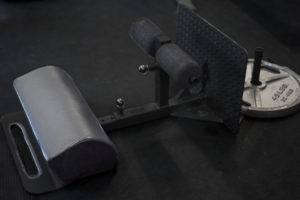 As a business owner and someone who’s been affiliated with EliteFTS for years, I’m sure you had some idea of the hurdles you’d have to overcome with a new invention, what was Dave Tate’s reaction when you told him you had an idea for a new kind of GHR and you wanted to build it and sell it?
As a business owner and someone who’s been affiliated with EliteFTS for years, I’m sure you had some idea of the hurdles you’d have to overcome with a new invention, what was Dave Tate’s reaction when you told him you had an idea for a new kind of GHR and you wanted to build it and sell it?
Dave has always been supportive of all of my ventures. He did warn me that designing and manufacturing equipment is expensive and that the profit margin is small. He was right. Thankfully he also said that as long as there weren’t similar products like it on the site and I had insurance then he would be willing to promote it.
I ask that because he said in the past that the first piece of equipment he bought for his home gym was a full size GHR so he could train on it without having to drive all of the way to Westside Barbell. What was his reaction to the Home GHR design when you showed him?
That’s an interesting fact. I didn’t know that. Honestly he didn’t say too much about the actual design other than that he was willing to put it on the site.
The product development process is rarely straight forward, how long did it take to get the Home GHR out of your head and to just the prototype phase?
That’s a good question. It took at least a year to get it from the design to an actual prototype, then it took another few months to work out the kinks until we had the final design and were ready to sell.
Where did you do your product testing for the prototype was it at the EliteFTS compound, at Orlando Barbell or a combination of the two? Did you send any versions of the product to friends to get feedback?
All of the original testing was done here at Orlando Barbell. Eventually I sent one to the Elitefts compound as well.
What version was it that finally came out in 2009-2010? How many incarnations had there been before it ever hit the “showroom floor”?
That’s a good question. Since I’m not an engineer, initially I draw to scale models of each design. The engineers who work for the steel company then draw them in AutoCAD. This makes the modifications much easier than having to actually make repeated designs. The first design was pretty close to the final model with just a few minor modifications.
With all of that testing, you obviously got feedback from customers once it was available to the public because you enlarged the floor plate and made it sturdier. How long was the process of changing the design to include the new improvements and how did that affect your patent application?
I actually had the foot plate enlarged and widened the base before it was ever sold. Some of the videos on youtube have the original design, but that one was never sold to any customers. I did end up modifying the pad after a couple of years. I worked with a custom made pad company to make it more comfortable by designing a specific one that did a better job of covering up the board at its base.
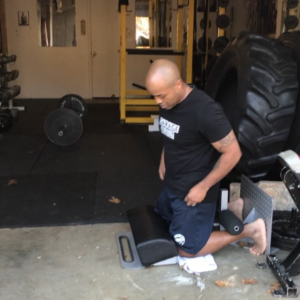 I’ve personally owned your Home GHR since 2016 and it’s holding up fairly well. It was one of the updated models. Have you made any further refinements since I bought mine?
I’ve personally owned your Home GHR since 2016 and it’s holding up fairly well. It was one of the updated models. Have you made any further refinements since I bought mine?
Thank you for purchasing the Home GHR. The only thing that has changed is that I worked with a company to design a better pad that more effectively covers the board at the base of the pad.
Why did you decide not to include a pad for under the users knees?
Placing a pad at under the existing knee pad would actually limit the range of motion and prevent the necessary knee mobility required to effectively perform the motion. Ideally users of the Home GHR should initially start with their knees on the floor then once the motion begins they should barely touch, if at all. Once this motion gets too easy they can move the knee pad closer to the foot plate so that their knees are elevated throughout the entire motion which will actually make the motion more concentrated on the hamstrings and thus more difficult.
I remember when I first got it; I’d only used a standard GHR a couple of times and my powerlifting coach, Steve Goggins, told me that I needed a ton of hamstring work. I could only do a GHR by using bands to assist me in coming up. Do you advise beginners to use the push up method to assist them in coming back up until they get stronger?
That’s cool that you’re coached by Steve Goggins. He’s a good guy and is a legend in the sport of Powerlifting. Absolutely, users should incorporate a push up while first using the Home GHR. That’s the biggest benefit of the design. It’s better for them to learn how to perform the motion correctly, even if they need to incorporate some upper body assistance
For the sake of those who are only familiar with hyperextension stations or who might have only seen full size GHDs used for ab work in CrossFit competitions, explain why the glute ham raise is so critical for lifters and other athletes like sprinters.
Glute ham raises incorporate both knee flexion and hip extension simultaneously, exactly as they’re used during sprints, squats, deadlifts and most motions involved in sports. The knee flexion that’s involved with a leg curl or manual leg curl only involves knee flexion and is very limited and unpractical to motions other than something like a kicking motion. Here’s a link to an article I wrote for EliteFTS on the topic.
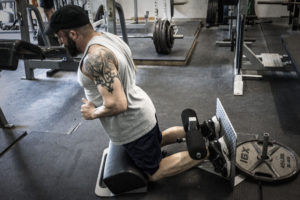 When I was shopping for a GHR that wouldn’t take up too much space in my garage gym, I saw yours and the version by Rogue. I realize that you have a patent pending on the product; was yours the first Home GHR product or did you see what else was out there and realize that you had a chance to improve on what they offered?
When I was shopping for a GHR that wouldn’t take up too much space in my garage gym, I saw yours and the version by Rogue. I realize that you have a patent pending on the product; was yours the first Home GHR product or did you see what else was out there and realize that you had a chance to improve on what they offered?
As far as I knew my design was the only floor based GHR. After mine was released in 2010 I saw numerous other versions start popping up. They say that imitation is the sincerest form of flattery, but I’m not so sure.
I chose your product because not having a Rogue rack, I didn’t want to go through the work of modifying a GHR to fit my Dynabody rack. I also didn’t like that other designs required a partner, so the counter weight was the perfect solution for me. What other aspects of your product separate it from what’s out there?
The design and angle of the Home GHR are exactly the same as a full sized model, just without the frame. If you’re looking to focus on performing the GHR motion correctly, while paying a fraction of the cost and taking up less space, the Home GHR is the way to go.
It’s funny now because so many people aren’t aware that compact versions of the GHR exist, that I still see a ton of videos of people kneeling down backwards on the lat pulldown or hooking their feet under barbells to do bird feeders. Briefly explain why your product is a better alternative to Nordic curls or those makeshift solutions.
I touched on this a little bit earlier, but the glute ham raise motion incorporates both knee flexion and hip extension while a manual leg curl, or Nordic curl, are limited to just knee flexion since they don’t incorporate the hip motion at all. The Home GHR is also more comfortable than trying to awkwardly hook your feet into a machine to perform a motion that it’s not meant for. It also doesn’t require a partner.
Product reviewer Joe Gray, who does one year reviews for Garage Gym Magazine as well as his own site, said, “My biggest concern with a floor model, is I like the ability to do back Extensions and reverse hypers off my full sized GHD.” Space is always limited in home gyms. What do you say to home gym owners who tend to prefer equipment that fulfills multiple functions and might hesitate to buy a product that seems to only do one thing?
There are a lot of options to perform low back exercises such as with Good Mornings, Stiff Deads or RDLs but there’s no other way to strengthen your hamstrings and glutes like a GHR other than with a GHR. Also, I would never recommend it, but I have seen on websites where lifters talked about having secured (and I mean securely secured like with tow straps) their Home GHRs to a bench so they could achieve greater ROM.
You list all of the exercises that can be performed with the Home GHR and most of them are variations on the glute ham raise but I never thought about doing rear delt raises! Do you have a video demonstrating that? How is it more effective to do rear delt raises with the Home GHR than free standing or lying on a bench?
I do actually. Here’s the link. The rear delt motion isn’t necessarily more effective this way, but it’s a good way to incorporate the low back as well as some variety.
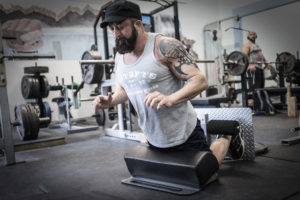 Besides the ab wheel GHR what other abdominal exercises can be done with the Home GHR?
Besides the ab wheel GHR what other abdominal exercises can be done with the Home GHR?
- Here’s my friend, Elizabeth Lessmann, performing the basic crunch on the Home GHR.
- Here’s me using a med ball as resistance.
- Here’s me performing both GHRs and abs against bands.
- Here’s another variation of the ab wheel combo where I incorporate some band resistance.
I will admit that I’ve been trying to come up with a way to mount the Home GHR on a box so I could go all of the way down. But I saw you mention in a video that, it’s actually better to stop when you’re parallel to the floor. I linked the video so people could watch it but could you unpack a little bit more why stopping at parallel is better? Is it sort of like Spoto Presses or touch and go deadlifts where you’re maintaining tension the entire time?
The primary reason why stopping at parallel with the ground is so beneficial is because if you go past that point you start incorporating momentum. Once you incorporate momentum you reduce the isolation on your hamstrings and glutes and are essentially cheating, just like swinging up a curl.
Here’s a link to an article I wrote for Elitefts: “You Need a Glute Ham Raise- Here’s Why” that may be good to check out.
Thanks for all of the information Brian! If anyone has follow up questions about this or any of your other products, or even wants to reach out for training, how do they reach you?
You can order a Home GHR from OBBstrength.com or EliteFTS.com. If you order it from OrlandoBarbell.com, Brian has graciously extended a 10% off discount to our readers. Just input promo code GARAGELIFTER at checkout. Don’t forget to give him a review once you’ve had a chance to try it out!

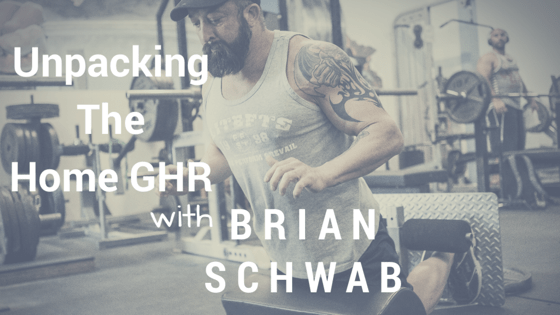
Pingback: Sammy Sebok the Iron Saint Talks Powerlifting Success